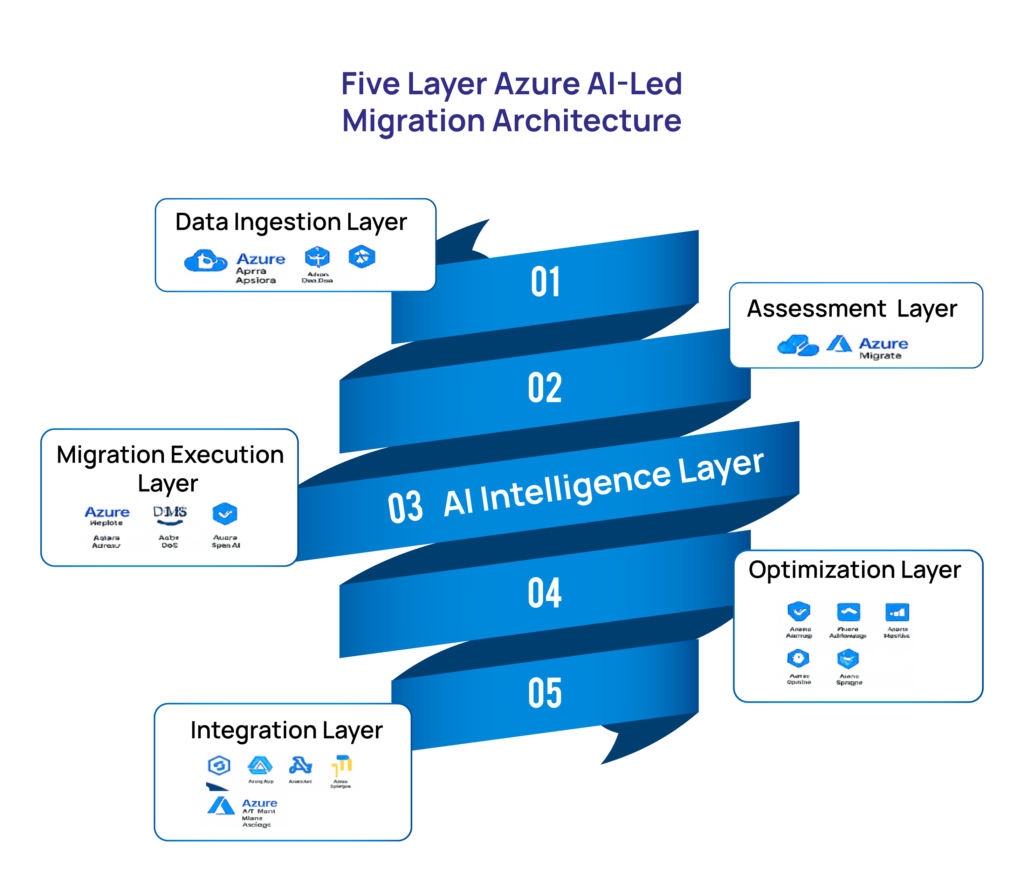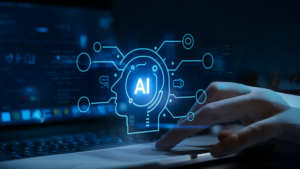


Ezhilvendan Selvam
5 Minutes read
AI-Led Data Center to Cloud Migration with Microsoft Azure: From Lift-and-Shift to Intelligent Transformation
It’s 2 AM on a global trading floor. Millions of transactions are firing every second. Behind the scenes, those trades depend on servers tucked away in aging data centers. The problem? Storage is maxed out, costs are climbing, and resilience is being tested daily.
Now imagine migrating that entire infrastructure to the cloud. Traditionally, this process takes months of manual audits, dependency spreadsheets, endless cutovers — and plenty of sleepless nights for IT teams. A single missed dependency could mean hours of downtime.
But what if migration didn’t have to be this way? What if workloads could be discovered, replicated, and optimized automatically? What if risks could be predicted before execution? This is the promise of an AI-led data center to cloud migration with Microsoft Azure.
Why Now?
Cloud migration isn’t new — but the urgency is unprecedented.
- Complexity is rising: Data centers host a mix of legacy apps, VMs, and hybrid workloads.
- Economics are shifting: Businesses are under pressure to turn CapEx-heavy data centers into OpEx-driven cloud platforms.
- Downtime is unacceptable: Always-on digital operations demand zero disruption.
- AI has matured: Azure now embeds AI across every migration and optimization layer, transforming automation into intelligent orchestration.
How AI Changes the Game
Think of a cloud migration as moving an entire city. Every connection — from power to water to roads — must be mapped before the first building moves. Historically, this mapping was manual, error-prone, and slow.
With AI and Microsoft Azure
- Dependencies are auto-discovered using Azure Migrate and AI-based dependency visualization.
- Readiness scoring and cost modeling simulate different migration strategies using Azure Cost Management + Machine Learning models.
- Generative AI modernizes legacy applications, automatically refactoring monolithic workloads into containerized microservices on Azure Kubernetes Service (AKS).
- AI-driven operations post-migration continuously rightsize compute, storage, and databases through Azure Advisor and Automanage insights.
Instead of firefighting, enterprises move toward autonomous migration — faster, safer, and smarter.
The Business Impact
- Accelerated Cloud Adoption – With AI-driven discovery, assessment, and execution, organizations can reduce migration timelines from years to months. Automated dependency grouping and replication remove manual overhead, accelerating time to value.
- Cost Savings – AI-based rightsizing and predictive scaling through Azure Advisor and Cost Management deliver 20–40% infrastructure savings. AI FinOps insights detect idle resources and optimize workloads dynamically.
- Resilience and Availability – AI-powered anomaly detection in Azure Monitor and Application Insights enhances uptime by proactively identifying performance degradation before users are affected.
- Security and Compliance – AI-enhanced tools like Microsoft Defender for Cloud and Azure Policy continuously enforce regulatory compliance — from HIPAA and PCI-DSS to GDPR — across hybrid environments.
The Five-Layer Azure Architecture
Every AI-led migration to Azure can be visualized as a five-layer pipeline, with an AI Intelligence Layer embedded across all stages.
- Data Ingestion Layer – Azure Migrate: Discovery and Assessment gathers metadata about servers, VMs, and application dependencies.
- Assessment Layer- AI models calculate readiness scores, estimate TCO, and simulate resource requirements via Azure Migrate, Resource Graph, and Cost Management.
- Migration Execution Layer- Azure Migrate: Server Migration, Azure Database Migration Service (DMS), and Data Box Edge orchestrate lift-and-shift or refactored migrations with near-zero downtime.
- Optimization Layer- Azure Advisor, Automanage, and Azure Monitor AI insights continuously fine-tune performance, cost, and governance post-migration.
- Integration Layer- Migrated workloads integrate with Azure Synapse, Fabric, AI Copilot, and Power BI for advanced analytics and business insights.
AI Intelligence Layer- A horizontal AI capability spanning every layer — automating discovery, predicting outcomes, and optimizing continuously.

Key Benefits
- Faster Time to Value: AI automation compresses migration timelines.
- Reduced Risk: Intelligent dependency analysis minimizes outages.
- Lower Costs: Predictive rightsizing avoids overprovisioning.
- Enhanced Security: Continuous AI-driven monitoring and compliance enforcement.
- Future-Ready Foundation: Establishes an AI-native cloud backbone for ongoing innovation.
Challenges
- Legacy Dependencies: Some middleware or OS versions may resist AI-led refactoring.
- Data Gravity: Large datasets require high-speed migration with Azure Data Box.
- Change Management: Business alignment is key to minimizing disruption.
- Multi-Cloud Integration: Connecting Azure with existing hybrid systems adds complexity.
- Skill Gaps: Enterprises often lack AI and Azure migration expertise internally.
ACL Digital’s Approach
ACL Digital enables enterprises to migrate to Azure with speed, safety, and intelligence through a proven AI-first methodology.
- AI-Driven Assessment Accelerators: Automated workload discovery, dependency mapping, and cost simulation powered by ACL’s internal AI models integrated with Azure Migrate APIs.
- Generative AI Modernization Frameworks: Using Azure OpenAI Service to refactor legacy codebases, generate API documentation, and convert monoliths into container-ready microservices.
- Cloud-Agnostic Strategy: Integration with Azure Arc for hybrid and multi-cloud scenarios.
- Continuous Optimization: AI-based governance and performance management using Azure Advisor, Automanage, and FinOps Insights.
Use Cases
Use Case 1: Healthcare Systems Migration with Compliance
A healthcare provider needed to migrate Electronic Health Records (EHR) and imaging systems to Azure while maintaining HIPAA and GDPR compliance.
AI-driven workload grouping through Azure Migrate identified sensitive data sets requiring encryption. Azure DMS replicated records, and Defender for Cloud ensured ongoing data protection.
Outcome: 100% HIPAA compliance, zero data loss, and 35% lower storage cost via Azure Blob lifecycle management.
Use Case 2: Manufacturing ERP Modernization
A global manufacturer running an aging ERP system sought to modernize and scale globally.
Generative AI models via Azure OpenAI refactored ERP modules into microservices. Azure Kubernetes Service (AKS) hosted the new architecture, and Azure Monitor applied predictive analytics for production stability.
Outcome: 45% faster modernization, 25% operational efficiency gain, and near-zero downtime during rollout.
Use Case 3: Retail Omnichannel Transformation
A leading retailer needed to unify its e-commerce and in-store systems without outages during seasonal spikes.
AI-powered scaling via Azure Autoscale and AI Insights ensured elasticity. Azure DMS migrated customer data to Azure SQL Database, while predictive FinOps prepared for traffic surges.
Outcome: Zero outages, 30% faster response times, and 20% infrastructure cost reduction.
AI Impact Metrics
- 50% reduction in assessment and dependency mapping time
- 40% faster cutover execution
- 25% fewer post-migration performance incidents
- 20–40% operational cost optimization
- 100% compliance alignment through AI governance
Future Outlook
As Microsoft continues embedding Copilot and OpenAI across Azure services, the next era of migrations will be:
- Predictive: Demand-aware scaling before traffic peaks.
- Autonomous: AI-driven cloud-to-cloud workload movement.
- Self-Healing: Systems that detect and remediate issues automatically.
- Cognitive FinOps: Real-time, AI-managed financial optimization.
Key Takeaways
- Azure provides an AI-empowered migration ecosystem that simplifies discovery, execution, and optimization.
- AI ensures faster adoption, reduced risk, and cost efficiency.
- ACL Digital’s AI-first modernization accelerators deliver measurable transformation for healthcare, manufacturing, and retail sectors.
ACL Digital’s Proven Expertise in Azure & AI
ACL Digital has delivered large-scale, AI-led Azure migrations across industries — modernizing complex data centers into resilient, cost-efficient, and compliant cloud ecosystems.
Our capabilities include:
- AI-driven workload discovery & migration accelerators
- Generative AI modernization frameworks on Azure OpenAI
- Azure-native observability, FinOps, and governance integration
- End-to-end hybrid and multi-cloud migration services
We help enterprises migrate with confidence, intelligence, and speed — building future-ready IT foundations on Azure.
Conclusion
AI-led migration with Microsoft Azure is more than a technical shift — it’s a strategic leap toward intelligent infrastructure.
By combining Azure’s advanced migration toolchain with ACL Digital’s AI-driven accelerators, enterprises can achieve faster transitions, reduced costs, and smarter operations.
Connect with ACL Digital’s Cloud & AI experts at business@acldigital.comto explore AI-led migration frameworks, readiness assessments, and modernization strategies tailored for your enterprise.
Related Insights


AI-Powered Personalization – How Devices Learn, Adapt, and Anticipate You




